[English] 日本語
 Yorodumi
Yorodumi- PDB-1frt: CRYSTAL STRUCTURE OF THE COMPLEX OF RAT NEONATAL FC RECEPTOR WITH FC -
+ Open data
Open data
- Basic information
Basic information
| Entry | Database: PDB / ID: 1frt | |||||||||
|---|---|---|---|---|---|---|---|---|---|---|
| Title | CRYSTAL STRUCTURE OF THE COMPLEX OF RAT NEONATAL FC RECEPTOR WITH FC | |||||||||
 Components Components |
| |||||||||
 Keywords Keywords | COMPLEX (RECEPTOR/IMMUNOGLOBULIN) / COMPLEX (RECEPTOR-IMMUNOGLOBULIN) / COMPLEX (RECEPTOR-IMMUNOGLOBULIN) complex | |||||||||
| Function / homology |  Function and homology information Function and homology informationIgG receptor activity / Endosomal/Vacuolar pathway / DAP12 interactions / Immunoregulatory interactions between a Lymphoid and a non-Lymphoid cell / Antigen Presentation: Folding, assembly and peptide loading of class I MHC / ER-Phagosome pathway / DAP12 signaling / IgG binding / Neutrophil degranulation /  humoral immune response ...IgG receptor activity / Endosomal/Vacuolar pathway / DAP12 interactions / Immunoregulatory interactions between a Lymphoid and a non-Lymphoid cell / Antigen Presentation: Folding, assembly and peptide loading of class I MHC / ER-Phagosome pathway / DAP12 signaling / IgG binding / Neutrophil degranulation / humoral immune response ...IgG receptor activity / Endosomal/Vacuolar pathway / DAP12 interactions / Immunoregulatory interactions between a Lymphoid and a non-Lymphoid cell / Antigen Presentation: Folding, assembly and peptide loading of class I MHC / ER-Phagosome pathway / DAP12 signaling / IgG binding / Neutrophil degranulation /  humoral immune response / response to cadmium ion / humoral immune response / response to cadmium ion /  beta-2-microglobulin binding / antigen processing and presentation of exogenous protein antigen via MHC class Ib, TAP-dependent / cellular response to iron(III) ion / negative regulation of forebrain neuron differentiation / response to molecule of bacterial origin / beta-2-microglobulin binding / antigen processing and presentation of exogenous protein antigen via MHC class Ib, TAP-dependent / cellular response to iron(III) ion / negative regulation of forebrain neuron differentiation / response to molecule of bacterial origin /  regulation of erythrocyte differentiation / regulation of iron ion transport / MHC class I peptide loading complex / HFE-transferrin receptor complex / T cell mediated cytotoxicity / cellular response to iron ion / antigen processing and presentation of endogenous peptide antigen via MHC class I / positive regulation of T cell cytokine production / MHC class I protein complex / multicellular organismal-level iron ion homeostasis / positive regulation of T cell mediated cytotoxicity / peptide antigen assembly with MHC class II protein complex / negative regulation of neurogenesis / MHC class II protein complex / positive regulation of receptor-mediated endocytosis / cellular response to nicotine / peptide antigen binding / positive regulation of cellular senescence / antigen processing and presentation of exogenous peptide antigen via MHC class II / positive regulation of immune response / negative regulation of epithelial cell proliferation / positive regulation of T cell activation / sensory perception of smell / negative regulation of neuron projection development / MHC class II protein complex binding / late endosome membrane / T cell differentiation in thymus / iron ion transport / protein refolding / protein homotetramerization / intracellular iron ion homeostasis / amyloid fibril formation / learning or memory / endosome membrane / regulation of erythrocyte differentiation / regulation of iron ion transport / MHC class I peptide loading complex / HFE-transferrin receptor complex / T cell mediated cytotoxicity / cellular response to iron ion / antigen processing and presentation of endogenous peptide antigen via MHC class I / positive regulation of T cell cytokine production / MHC class I protein complex / multicellular organismal-level iron ion homeostasis / positive regulation of T cell mediated cytotoxicity / peptide antigen assembly with MHC class II protein complex / negative regulation of neurogenesis / MHC class II protein complex / positive regulation of receptor-mediated endocytosis / cellular response to nicotine / peptide antigen binding / positive regulation of cellular senescence / antigen processing and presentation of exogenous peptide antigen via MHC class II / positive regulation of immune response / negative regulation of epithelial cell proliferation / positive regulation of T cell activation / sensory perception of smell / negative regulation of neuron projection development / MHC class II protein complex binding / late endosome membrane / T cell differentiation in thymus / iron ion transport / protein refolding / protein homotetramerization / intracellular iron ion homeostasis / amyloid fibril formation / learning or memory / endosome membrane /  immune response / response to xenobiotic stimulus / lysosomal membrane / external side of plasma membrane / protein homodimerization activity / immune response / response to xenobiotic stimulus / lysosomal membrane / external side of plasma membrane / protein homodimerization activity /  extracellular space / identical protein binding extracellular space / identical protein bindingSimilarity search - Function | |||||||||
| Biological species |   Rattus norvegicus (Norway rat) Rattus norvegicus (Norway rat) | |||||||||
| Method |  X-RAY DIFFRACTION / Resolution: 4.5 Å X-RAY DIFFRACTION / Resolution: 4.5 Å | |||||||||
 Authors Authors | Burmeister, W.P. / Bjorkman, P.J. | |||||||||
 Citation Citation |  Journal: Nature / Year: 1994 Journal: Nature / Year: 1994Title: Crystal structure of the complex of rat neonatal Fc receptor with Fc. Authors: Burmeister, W.P. / Huber, A.H. / Bjorkman, P.J. #1:  Journal: Nature / Year: 1994 Journal: Nature / Year: 1994Title: Crystal Structure at 2.2 Angstroms Resolution of the Mhc-Related Neonatal Fc Receptor Authors: Burmeister, W.P. / Gastinel, L.N. / Simister, N.E. / Blum, M.L. / Bjorkman, P.J. #2:  Journal: Immunity / Year: 1994 Journal: Immunity / Year: 1994Title: Investigation of the Interaction between the Class I Mhc-Related Fc Receptor and its Immunoglobulin G Ligand Authors: Raghavan, M. / Chen, M.Y. / Gastinel, L.N. / Bjorkman, P.J. #3:  Journal: J.Mol.Biol. / Year: 1993 Journal: J.Mol.Biol. / Year: 1993Title: Crystallization and Stoichiometry of Binding of a Complex between a Rat Intestinal Fc Receptor and Fc Authors: Huber, A.H. / Kelly, R.F. / Gastinel, L.N. / Bjorkman, P.J. #4:  Journal: Biochemistry / Year: 1981 Journal: Biochemistry / Year: 1981Title: Crystallographic Refinement and Atomic Models of a Human Fc Fragment and its Complex with Fragment B of Protein a from Staphylococcus Aureus at 2.9-And 2.8-Angstroms Resolution Authors: Deisenhofer, J. | |||||||||
| History |
|
- Structure visualization
Structure visualization
| Structure viewer | Molecule:  Molmil Molmil Jmol/JSmol Jmol/JSmol |
|---|
- Downloads & links
Downloads & links
- Download
Download
| PDBx/mmCIF format |  1frt.cif.gz 1frt.cif.gz | 129 KB | Display |  PDBx/mmCIF format PDBx/mmCIF format |
|---|---|---|---|---|
| PDB format |  pdb1frt.ent.gz pdb1frt.ent.gz | 101.2 KB | Display |  PDB format PDB format |
| PDBx/mmJSON format |  1frt.json.gz 1frt.json.gz | Tree view |  PDBx/mmJSON format PDBx/mmJSON format | |
| Others |  Other downloads Other downloads |
-Validation report
| Arichive directory |  https://data.pdbj.org/pub/pdb/validation_reports/fr/1frt https://data.pdbj.org/pub/pdb/validation_reports/fr/1frt ftp://data.pdbj.org/pub/pdb/validation_reports/fr/1frt ftp://data.pdbj.org/pub/pdb/validation_reports/fr/1frt | HTTPS FTP |
|---|
-Related structure data
| Similar structure data |
|---|
- Links
Links
- Assembly
Assembly
| Deposited unit | 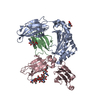
| ||||||||
|---|---|---|---|---|---|---|---|---|---|
| 1 | 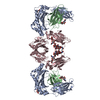
| ||||||||
| Unit cell |
| ||||||||
| Atom site foot note | 1: CIS PROLINE - PRO A 207 / 2: CIS PROLINE - PRO B 32 / 3: CIS PROLINE - PRO C 374 | ||||||||
| Details | MTRIX THE INFORMATION PRESENTED ON SYMMETRY RECORDS BELOW DESCRIBE TRANSFORMATIONS TO GENERATE CRYSTALLOGRAPHIC RELATIONSHIPS AS DESCRIBED IN THE STATEMENT THAT FOLLOWS EACH SYMMETRY OPERATOR. APPLIED TO TRANSFORMED TO MTRIX CHAIN RESIDUES CHAIN RESIDUES RMSD S1 C 1 - C 443 ? 1 - ? 443 THIS TRANSFORMATION GENERATES THE SECOND CHAIN OF THE FC MOLECULE. IF THE SAME OPERATION IS ALSO APPLIED TO THE FCRN MOLECULE, THE "STANDING UP" FCRNFC COMPLEX DISCUSSED IN THE ACCOMPANYING PAPER IS GENERATED. S2 A 1 - A 405 ? 1 - ? 405 S2 B 1 - B 99 ? 1 - ? 99 THIS TRANSFORMATION GENERATES THE SECOND SUBUNIT FOR THE "LYING DOWN" FC RECEPTOR DIMER PRESENTED IN THE ACCOMPANYING PAPER. SYMMETRY1 1 1.000000 0.000000 0.000000 0.00000 SYMMETRY2 1 0.000000 -1.000000 0.000000 145.00000 SYMMETRY3 1 0.000000 0.000000 -1.000000 108.25000 SYMMETRY1 2 -1.000000 0.000000 0.000000 250.00000 SYMMETRY2 2 0.000000 -1.000000 0.000000 72.50000 SYMMETRY3 2 0.000000 0.000000 1.000000 0.00000 |
- Components
Components
-Protein , 3 types, 3 molecules ABC
| #1: Protein |  Mass: 30322.887 Da / Num. of mol.: 1 Source method: isolated from a genetically manipulated source Source: (gene. exp.)   Rattus norvegicus (Norway rat) / Gene: BETA-2-MICROGLOBULIN / Organ: SERUM (MIXTURE OF SEVERAL SUBTYPES) / Plasmid: PBJ5-GS / Cell line (production host): CHO / Production host: Rattus norvegicus (Norway rat) / Gene: BETA-2-MICROGLOBULIN / Organ: SERUM (MIXTURE OF SEVERAL SUBTYPES) / Plasmid: PBJ5-GS / Cell line (production host): CHO / Production host:   Cricetulus griseus (Chinese hamster) / References: UniProt: P13599 Cricetulus griseus (Chinese hamster) / References: UniProt: P13599 |
|---|---|
| #2: Protein |  Beta-2 microglobulin Beta-2 microglobulinMass: 11652.282 Da / Num. of mol.: 1 Source method: isolated from a genetically manipulated source Source: (gene. exp.)   Rattus norvegicus (Norway rat) / Gene: BETA-2-MICROGLOBULIN / Organ: SERUM (MIXTURE OF SEVERAL SUBTYPES) / Plasmid: PBJ5-GS / Cell line (production host): CHO / Production host: Rattus norvegicus (Norway rat) / Gene: BETA-2-MICROGLOBULIN / Organ: SERUM (MIXTURE OF SEVERAL SUBTYPES) / Plasmid: PBJ5-GS / Cell line (production host): CHO / Production host:   Cricetulus griseus (Chinese hamster) / References: UniProt: P07151 Cricetulus griseus (Chinese hamster) / References: UniProt: P07151 |
| #3: Protein | Mass: 23422.539 Da / Num. of mol.: 1 Source method: isolated from a genetically manipulated source Source: (gene. exp.)   Rattus norvegicus (Norway rat) / Gene: BETA-2-MICROGLOBULIN / Organ: SERUM (MIXTURE OF SEVERAL SUBTYPES) / Plasmid: PBJ5-GS / Cell line (production host): CHO / Production host: Rattus norvegicus (Norway rat) / Gene: BETA-2-MICROGLOBULIN / Organ: SERUM (MIXTURE OF SEVERAL SUBTYPES) / Plasmid: PBJ5-GS / Cell line (production host): CHO / Production host:   Cricetulus griseus (Chinese hamster) / References: GenBank: 243866 Cricetulus griseus (Chinese hamster) / References: GenBank: 243866 |
-Sugars , 3 types, 3 molecules 
| #4: Polysaccharide | alpha-L-fucopyranose-(1-6)-2-acetamido-2-deoxy-beta-D-glucopyranose / Mass: 367.349 Da / Num. of mol.: 1 / Mass: 367.349 Da / Num. of mol.: 1Source method: isolated from a genetically manipulated source |
|---|---|
| #5: Polysaccharide | beta-D-galactopyranose-(1-4)-2-acetamido-2-deoxy-beta-D-glucopyranose-(1-2)-alpha-D-mannopyranose- ...beta-D-galactopyranose-(1-4)-2-acetamido-2-deoxy-beta-D-glucopyranose-(1-2)-alpha-D-mannopyranose-(1-6)-[2-acetamido-2-deoxy-beta-D-glucopyranose-(1-2)-alpha-D-mannopyranose-(1-3)]beta-D-mannopyranose-(1-4)-2-acetamido-2-deoxy-beta-D-glucopyranose-(1-4)-[alpha-L-fucopyranose-(1-6)]2-acetamido-2-deoxy-beta-D-glucopyranose / Mass: 1625.490 Da / Num. of mol.: 1 / Mass: 1625.490 Da / Num. of mol.: 1Source method: isolated from a genetically manipulated source |
| #6: Sugar | ChemComp-NAG /  N-Acetylglucosamine N-Acetylglucosamine |
-Details
| Sequence details | THERE ARE A NUMBER OF CLOSE CONTACTS BETWEEN ATOMS IN THIS THIS MOLECULE AND IN SYMMETRY-RELATED MOLECULES. |
|---|---|
| Source details | SOURCE 1 MOLECULE_NAME: FC (IGG) RECEPTOR, NEONATAL (FCRN) THE CELL LINE SECRETES A SOLUBLE FCRN ...SOURCE 1 MOLECULE_NAME: FC (IGG) RECEPTOR, NEONATAL (FCRN) THE CELL LINE SECRETES A SOLUBLE FCRN HETERODIME |
-Experimental details
-Experiment
| Experiment | Method:  X-RAY DIFFRACTION X-RAY DIFFRACTION |
|---|
- Sample preparation
Sample preparation
Crystal grow | *PLUS pH: 6.4 / Method: vapor diffusion | ||||||||||||||||||||||||||||||||||||
|---|---|---|---|---|---|---|---|---|---|---|---|---|---|---|---|---|---|---|---|---|---|---|---|---|---|---|---|---|---|---|---|---|---|---|---|---|---|
| Components of the solutions | *PLUS
|
-Data collection
| Radiation | Scattering type: x-ray |
|---|---|
| Radiation wavelength | Relative weight: 1 |
| Reflection | Num. obs: 8527 / % possible obs: 67 % / Observed criterion σ(I): 0 |
| Reflection | *PLUS Highest resolution: 4.5 Å / Lowest resolution: 25 Å / Redundancy: 3 % / Rmerge(I) obs: 0.125 |
| Reflection shell | *PLUS Highest resolution: 4.5 Å / Lowest resolution: 4.7 Å / % possible obs: 23 % / Rmerge(I) obs: 0.289 |
- Processing
Processing
| Software |
| ||||||||||||
|---|---|---|---|---|---|---|---|---|---|---|---|---|---|
| Refinement | Resolution: 4.5→20 Å / σ(F): 0
| ||||||||||||
| Displacement parameters | Biso mean: 199 Å2 | ||||||||||||
| Refinement step | Cycle: LAST / Resolution: 4.5→20 Å
|
 Movie
Movie Controller
Controller


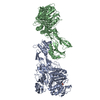
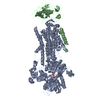
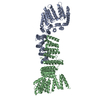
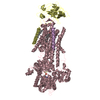

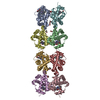
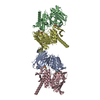
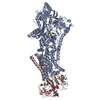
 PDBj
PDBj






